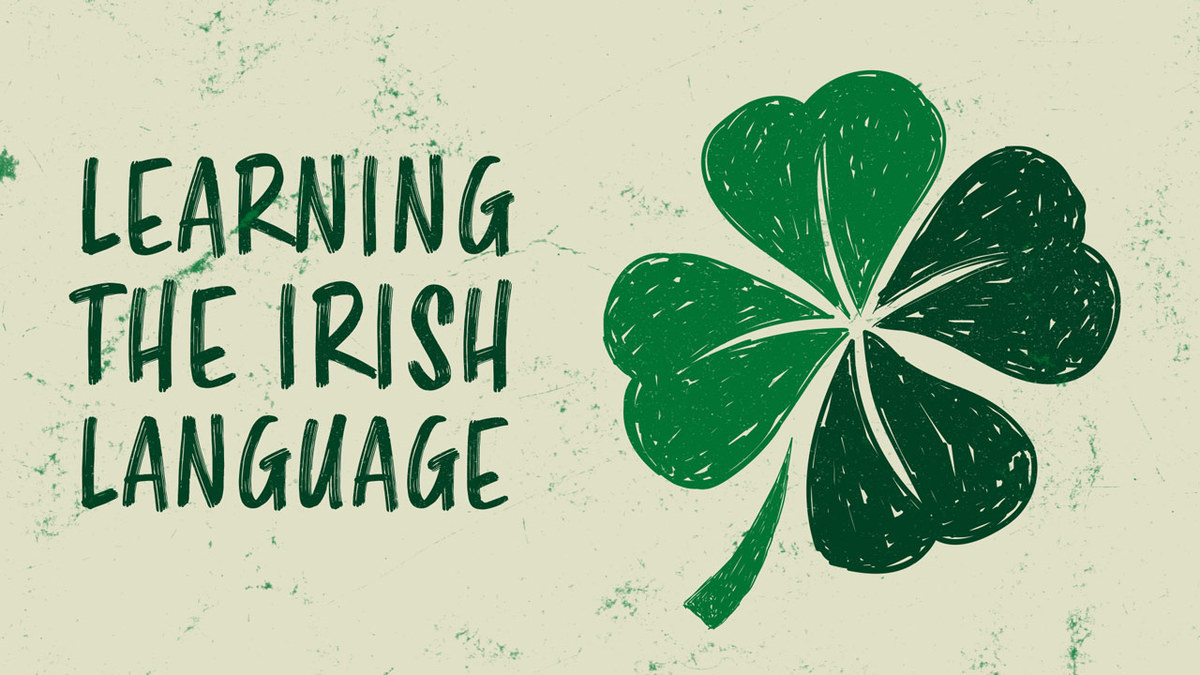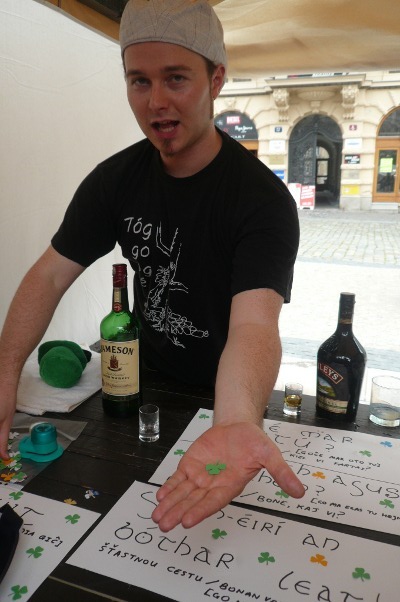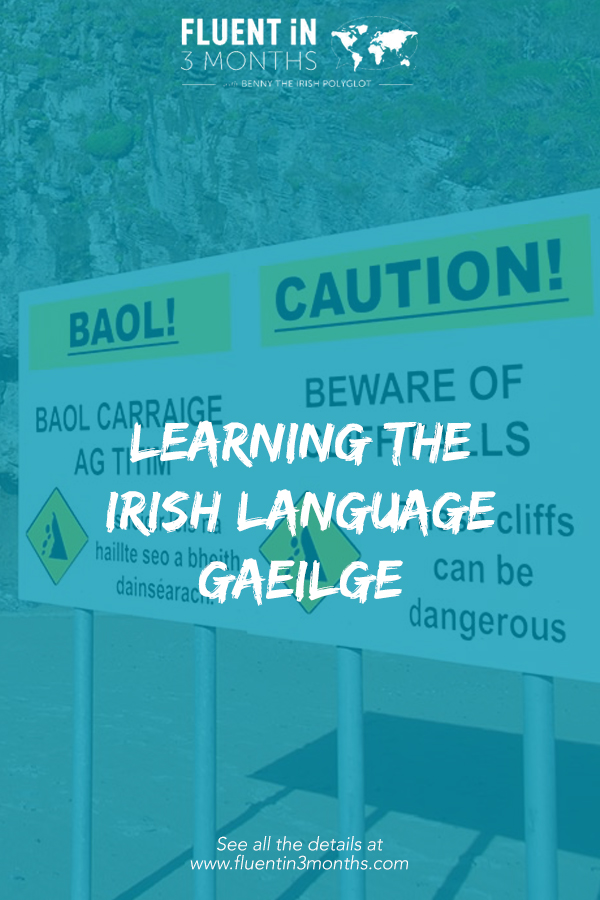How to Learn the Irish language (Gaeilge)
I’m happy to see that you’re interested in the Irish language!
Irish is the first official language of Ireland. Many people think it’s English with an Irish spin, but not at all!
The Irish language is also known as Gaeilge, and it’s a completely different language to English. I am here to tell you more about how it works and how you can learn it.
Here’s an overview of what we’ll talk about:
Table of contents
I wrote this post for Seachtain na Gaeilge(“Irish language week”). It’s the week celebrating the Irish language and culture leading up to St. Patrick's day.
So, are you ready to learn more about the Irish language?
Follow me!
What Is Gaeilge?
Gaeilge, Irish, or “Irish Gaelic” is the national and first official language of Ireland, as well as one of the official languages of the European Union.
Although everyone in Ireland speaks English, there are regions known as the Gaeltacht that use Irish as the main language, both in businesses and in families.
When we say Irish, the language, we don't mean our accent in English. That’s Hiberno English. No, we mean a language on a completely different branch of the European language family tree!
More distant than French and Spanish, stranger than Slavic languages and more exotic and beautiful than many languages, Irish is an interesting specimen.
Níl Sé Deacair ar Chor ar Bith – “It Is Not Difficult at All”
While Irish is quite different, there are some things that make it pretty straightforward to learn.
It only has 11 irregular verbs. That’s nothing compared to the 500 or so in English and thousands in Spanish/French/etc.!
There's also no indefinite articles, so you can just say Tá leabhar agam (literally I have book). And even though Gaeilge has masculine and feminine nouns, the definite article “an” (the) is the same for both.
Gaelic uses the same alphabet as other European languages. But it is the only language that still traditionally uses its own special font!
The phonetics (pronunciation based on spelling) are quite different, and this usually scares a lot of people. But you can learn the differences very quickly. After that, they are consistent. This means that you can read any given text aloud pretty well after a small amount of study.
Most of the letters work pretty similarly to how they do in most European languages, but some change. This includes:
- mb = m
- gc = c
- th = h
- dt = d,
- fh = silent
Some consonants change sound depending on if they are before i/e or a/o/u. This happens in Spanish/French/Italian and other languages too, but it’s slightly different in Irish.
For example S before i or e makes an sh sound. This is why the well-known name Seán is pronounced (and spelled, in America) as Shawn.
Most of the vowels work similarly to as they would in English, with the exception of ao pronounced as ee, so the name Aoife is pronounced Ee-fa.
The subtle difference between how some consonants are pronounced takes some practice, but you can indeed learn it 🙂 This is important for saying Irish people's names correctly. Even when you’re just speaking English.
Some titles are not translated in Ireland. Instead of a “prime minister”, we have a Taoiseach. ‘Ch' is pronounced gutturally as in loch. Based on that and what I said above, you will see better why this is pronounced Tee-sho[ch].
The Irish language also interestingly has no word for yes or no. We simply repeat the verb of the question. Like this: Ar ith tú do lón? D'ith! (“Did you eat your lunch? I did!”). Literally, it translates to “I ate”.
Cad Atá Tú Ag Caint Faoi? – “What Are You Talking About?”
There are a few tricky aspects of the language that deserve a mention.
In most languages, you change the end of words in certain situations.
Examples:
- to show plural: car → cars
- to change a verb’s tense: I eat → he eats
Other times, it’s the middle of the words that changes: man/men, mouse/mice.
In Irish, we very merrily change the beginning of words. This is something common in other Celtic languages and it adds to a nice flow between words.
For those of you who don't know, my name is actually Brendan (Benny is my nickname). In Irish, this is originally written Breandán. When followed by verbs and such, it stays the same:
Tá Breandán ag ithe – “Brendan is eating.”
However, thanks to the magic of initial mutations, we can change the start of words in many situations!
So if you want to get my attention some day, don't shout Breandán!! Instead, use A Bhreandán!! It is actually pronounced ah Vrendawn since bh=v!
(For the linguists out there who want to know the exact term to describe this change, it is the vocative case.)
Here’s another example: Mo (“my”) and madra (“dog”) become mo mhadra together. Since mh=w, this is pronounced mo wadra.
This strange use of spelling and the other examples mentioned above may seem off putting. But believe it or not, it's actually quite helpful! Let me explain.
We keep the letter of the original base word in a modified version of the word.
Example: crann (“tree”) becomes i gcrann (“in a tree”). The ‘c' is silent, but essential for recognising the original word when the modified one is written.
This is way better than if the language was perfectly phonetic. Even if you knew the word crann it would be much more confusing for you to see grann in a dictionary or text.
Welsh is in the same language family as Irish. I'm told that it works more phonetically despite the same initial mutation situation. I'd personally miss my original letters for recognition!
The vocabulary of the language is of course quite different. It's one of the few languages I've seen that has its own word for things like the Internet (Idirlíon). Even words you would hope would be slightly similar go way off: “vegetarian” is feoilséantóir (literally means, “meat shunner”).
But despite the huge differences, Irish words are formed logically using prefixes, suffixes and combinations of roots.
A lot of Irish words do this, so after you have some basic vocabulary it isn't that bad. You can recognise more complicated words and very quickly build up your base of vocabulary.
For example, astronomy is réalteolaíocht. Réalta is “star”, eolas is knowledge/information, and íocht is y/ity/other suffixes. More generally, the second part of réalteolaíocht, eolaíocht, means science. In the end, you get “star science”.
But sometimes we just separate the words in an easy way. “Exit” is simply bealach amach (“way out”).
You should also know that word order changes a bit from English. And we have preposition conjugation, like in Spanish/Portuguese when con and tu become contigo.
A fun fact to conclude the section with good humour: Because of the initial mutations mentioned above, capital letters (upper case) can occur as the second or third letter in a word! So Donegal, a county in the northwest is spelled Dún na nGall.
These things do take some getting used to, but it really isn't that bad 🙂
Resources to Learn Irish Gaelic
If you feel ready to get started on Gaeilge yourself, I’ve got a couple of resources to help you. Maybe you can use them to work towards having a 15-minute conversation in Gaeilge after 90 days!
I’ve listed the best ones here, but here are some more!
Even if you aren't in Ireland, the possibilities of listening to and practising Irish are endless! An idea that I've already mentioned before is to use meetup.com to see if there are other interested Irish learners in your city.
If you’re more of a solo learner, you can turn to books. Whether in Ireland or abroad, there are usually some books in major libraries on learning Irish.
If you can’t access them near you, you might need to look for them online. One of my favourites for beginners is the multimedia Turas Teanga course (you can get it on Amazon). It is from Irish language RTE newsreader Sharon Ní Bheolain. She teaches the language while going around the country showing it used by natives.
Teach Yourself is also a great book about Irish for complete beginners (Amazon).
The more adventurous of you can even read Harry Potter in Irish! (Amazon).
But reading doesn’t have to be long and hard! You can also try short, simple texts. I do this with all of my maintained languages. You can follow me on Twitter @ilteangach for small bits of Irish Gaelic.
You can also change the language of your computer and software to be entirely in Irish! Chrome, Firefox, Open Office, Ubuntu and many more interfaces are available as Gaeilge.
There are also lots of websites to help you practice your Irish. Here are some of my favourites:
- Gramadach na Gaeilge – It’s an extremely in-depth look at Irish grammar. Perhaps it’s more interesting to linguists. It gets very detailed!
- Daltaí forum
- Abair.ie – An amazing voice synthesiser for Irish text. It uses the beautiful Tír Conaill accent and can help train you in your pronunciation.
- RnaG – Listen to Ireland's main Irish language radio station live. This is the best way to hear what the language actually sounds like! The entire page is in Irish, but click on “RnaG beo” link beside the radio image in the top-right to open up the stream.
- Tg4 – This is Ireland's Irish language TV station. What's better than listening to the radio in Irish? Watching TV shows originally in Irish! Check out the Ros na Rún page (and click “Féach ar” [watch]) to watch a soap opera entirely in Irish!
- Focal.ie – Here’s a free dictionary database. It lists every Irish contemporary word found on the Internet. There are links to the page where you can find the words’ definitions.
Tá an Teanga I Ngach Ait! – “The Language Is Everywhere!”
The best part of all, is that Irish speakers are generally always happy to help!
We are a long cry from arrogant perfectionists, something that holds too many people back from speaking a language. If you can form some sentences, we'll be very happy to hear them. Even if there are some grammatical mistakes 🙂
Whenever I hear a cúpla focal (“a couple of words”) from someone, I always encourage them to keep going!
My Irish is far from perfect. My accent is definitely not as lovely as so many others that you would hear. But I enjoy the language!
The course I took to learn Gaeilge was given by Oideas Gael in Donegal and takes place regularly every year for all levels.
You can check out a video I made about my experience in the Gaeltacht. Or maybe you’d like to see me introduce Irish as a leprechaun.
If you’re curious about the Irish language, I hope this post gives you a little hint into how to learn and use it!
Don't forget to share this post with your other Irish-at-heart friends through twitter and facebook 🙂
Go n-eirí an bóthar libh!





Social